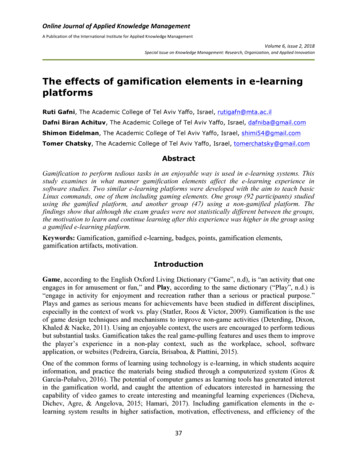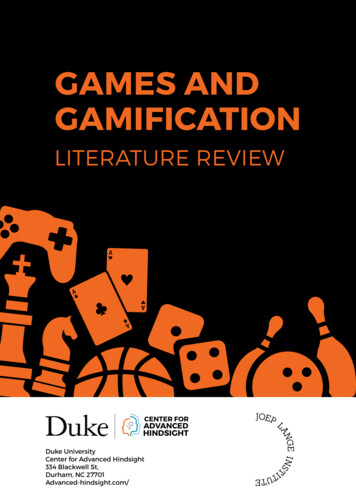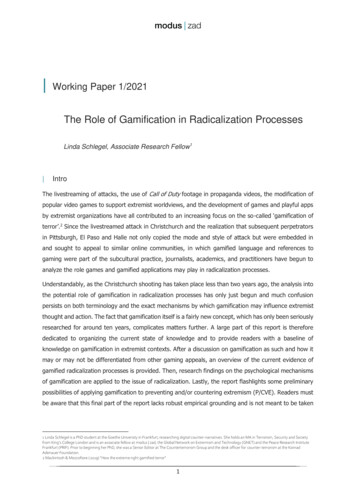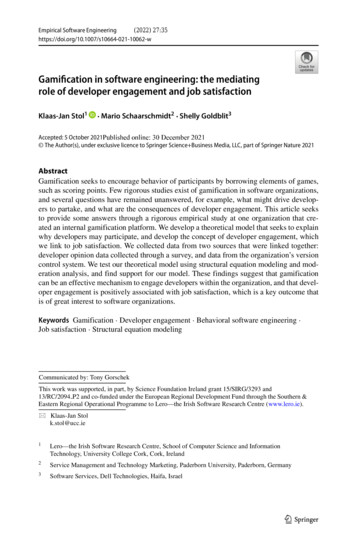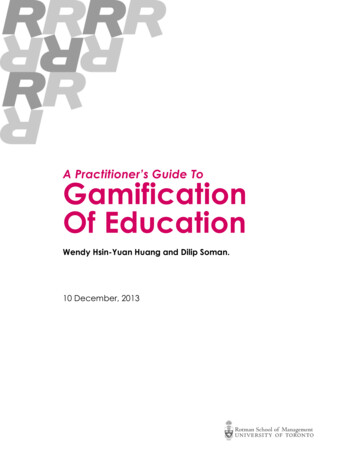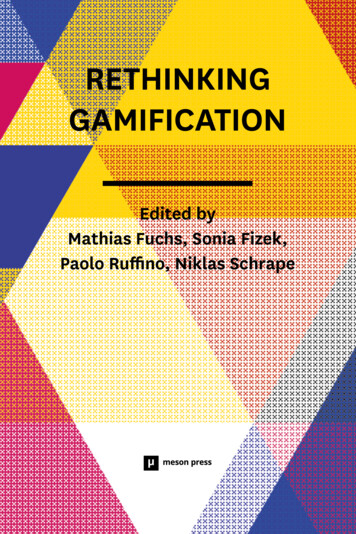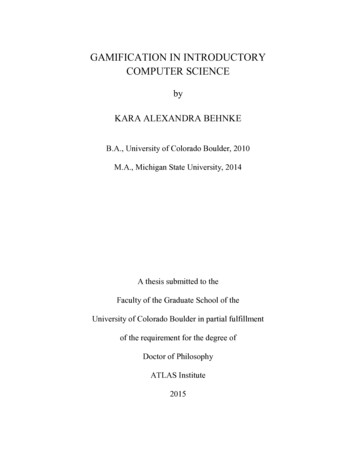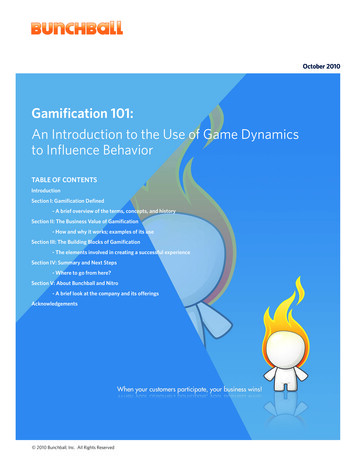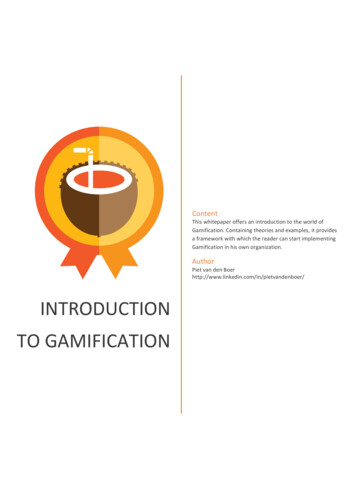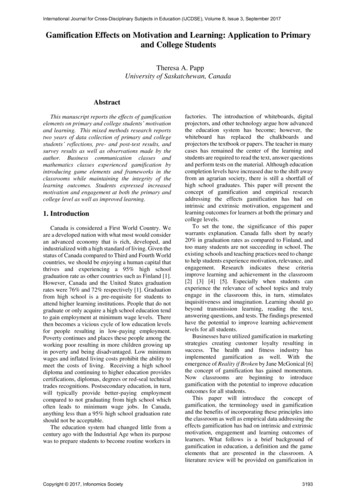
Transcription
International Journal for Cross-Disciplinary Subjects in Education (IJCDSE), Volume 8, Issue 3, September 2017Gamification Effects on Motivation and Learning: Application to Primaryand College StudentsTheresa A. PappUniversity of Saskatchewan, CanadaAbstractThis manuscript reports the effects of gamificationelements on primary and college students’ motivationand learning. This mixed methods research reportstwo years of data collection of primary and collegestudents’ reflections, pre- and post-test results, andsurvey results as well as observations made by theauthor. Business communication classes andmathematics classes experienced gamification byintroducing game elements and frameworks in theclassrooms while maintaining the integrity of thelearning outcomes. Students expressed increasedmotivation and engagement at both the primary andcollege level as well as improved learning.1. IntroductionCanada is considered a First World Country. Weare a developed nation with what most would consideran advanced economy that is rich, developed, andindustrialized with a high standard of living. Given thestatus of Canada compared to Third and Fourth Worldcountries, we should be enjoying a human capital thatthrives and experiencing a 95% high schoolgraduation rate as other countries such as Finland [1].However, Canada and the United States graduationrates were 76% and 72% respectively [1]. Graduationfrom high school is a pre-requisite for students toattend higher learning institutions. People that do notgraduate or only acquire a high school education tendto gain employment at minimum wage levels. Therethen becomes a vicious cycle of low education levelsfor people resulting in low-paying employment.Poverty continues and places these people among theworking poor resulting in more children growing upin poverty and being disadvantaged. Low minimumwages and inflated living costs prohibit the ability tomeet the costs of living. Receiving a high schooldiploma and continuing to higher education providescertifications, diplomas, degrees or red-seal technicaltrades recognitions. Postsecondary education, in turn,will typically provide better-paying employmentcompared to not graduating from high school whichoften leads to minimum wage jobs. In Canada,anything less than a 95% high school graduation rateshould not be acceptable.The education system had changed little from acentury ago with the Industrial Age when its purposewas to prepare students to become routine workers inCopyright 2017, Infonomics Societyfactories. The introduction of whiteboards, digitalprojectors, and other technology argue how advancedthe education system has become; however, thewhiteboard has replaced the chalkboards andprojectors the textbook or papers. The teacher in manycases has remained the center of the learning andstudents are required to read the text, answer questionsand perform tests on the material. Although educationcompletion levels have increased due to the shift awayfrom an agrarian society, there is still a shortfall ofhigh school graduates. This paper will present theconcept of gamification and empirical researchaddressing the effects gamification has had onintrinsic and extrinsic motivation, engagement andlearning outcomes for learners at both the primary andcollege levels.To set the tone, the significance of this paperwarrants explanation. Canada falls short by nearly20% in graduation rates as compared to Finland, andtoo many students are not succeeding in school. Theexisting schools and teaching practices need to changeto help students experience motivation, relevance, andengagement. Research indicates these criteriaimprove learning and achievement in the classroom[2] [3] [4] [5]. Especially when students canexperience the relevance of school topics and trulyengage in the classroom this, in turn, stimulatesinquisitiveness and imagination. Learning should gobeyond transmission learning, reading the text,answering questions, and tests. The findings presentedhave the potential to improve learning achievementlevels for all students.Businesses have utilized gamification in marketingstrategies creating customer loyalty resulting insuccess. The health and fitness industry hasimplemented gamification as well. With theemergence of Reality if Broken by Jane McGonical [6]the concept of gamification has gained momentum.Now classrooms are beginning to introducegamification with the potential to improve educationoutcomes for all students.This paper will introduce the concept ofgamification, the terminology used in gamificationand the benefits of incorporating these principles intothe classroom as well as empirical data addressing theeffects gamification has had on intrinsic and extrinsicmotivation, engagement and learning outcomes oflearners. What follows is a brief background ofgamification in education, a definition and the gameelements that are presented in the classroom. Aliterature review will be provided on gamification in3193
International Journal for Cross-Disciplinary Subjects in Education (IJCDSE), Volume 8, Issue 3, September 2017education as well as the systematic mapping ofcategorical applications in education. Thepedagogical theories that are present in gamificationare presented. The paper provides a quantitativeanalysis of data collected from primary and collegestudents on their experiences in a class that wasgamified along with qualitative responses about theexperience.2. Background: GamificationGamification has been defined as the use of gamedesign elements in non-game contexts such aseducation [7]. Gamification has been in existence forless than a decade and is a new term documented in2008 that is a growing phenomenon [7]. Themomentum that began over thirty years ago with theadvent of the video game has now escalated and nowgames and game apps are part of everyday life for allages of people. However, the concept has beenrecognized to hold value in 1954 by Mood and Specht[8]. In a government report, Mood and Specht stated“a virtue of gaming that is sometimes overlooked bythose seeking grander goals . . . is its unparalleledadvantages in training and educational programs. Agame can easily be made fascinating enough to putover the dullest facts” (p. 12-13).There remains a negative connotation surroundingthe gamification concept. Perhaps this comes from theroot word being game and that is equated to play,entertainment, nonproductivity, and having fun whichtypically is not associated with learning [9] [7] [10][11]. On the other side of the continuum is thefalsehood that gamification is a panacea for alllearning and all learners. Gamification is supported byevidence-based research that legitimizes the use oflearning theories and principles through itsimplementation verifying that the process is not justplay. Gee [12] identified 36 learning principles thatare present in the gamification process. These includecritical learning, design, semiotic domains, meta levelthinking, self-knowledge and achievement learningprinciples just to name a few. Ryan and Deci [13]provided research evidence on intrinsic and extrinsicmotivation and that self-determination theory isevident in gamification as well as social learningtheory [14]. Scaffolding is used throughout thegamification process [15]. Also present, is the theoryof motivation [16] as well as flow theory [17].Nah,Zeng,Telaprolu,Ayyappa,andEschenbrenner [18] conducted a review of theliterature on gamification in education. Theirsynthesis identified the design elements utilized togamify education were the following: points, levels orstages, badges, leaderboards, prizes and rewards,progress bars, storyline, and feedback. Studentsexperience motivation and engagement whichenhances learning when these various game elementsare used in a classroom situation [19].Copyright 2017, Infonomics SocietyDicheva, Dichev, Agre, and Angelova [20]conducted a systematic mapping study ofgamification in education from several researchpapers and revealed the categories of design principlesincluded were: goals and challenges, personalization,rapid feedback, visible status, freedom of choice,freedom to fail, and social engagement. The mostpopular design principles were individual and groupchallenges where competition created socialengagement and visible status were reported [20]. Itwas noted that most of the gamification of educationand reported research was conducted in science,engineering, information and computer technology atthe college level [20], [18].Specific researchers that have implemented andconducted research on gamification have documentedthe effectiveness of using gamification in classrooms[12] [11] [19] [21]. Research has also indicated thatthere are benefits to playing video games that improvecognitive abilities (attention, focus and reaction time),motivation, emotional and social benefits [22]. Gee[12] stated, “in fact, the learning principles that goodgames incorporate are all strongly supported bycontemporary research in cognitive science – thescience that studies human thinking and learningthrough laboratory research, studies of the brain, andresearch at actual learning sites like classrooms andworkplaces” (p. 1). Given the promising results andthe grounding of theories and learning principles inthe gamification process, more empirical researchneeds to be conducted. This study was carried out todiscover the influences of gamification on studentsand learning in a non-technology discipline as well asthe effects on learning outcomes. The followingsection will describe the research paradigm, theconceptual framework used to analyze the data,participant selection, and data collection.3. Research MethodologyThis study involved six business communicationclasses of college students and two mathematicsclasses comprised of grade four students. The purposeof this mixed research study is to identify the students’perception of the impact gamification had on theirlearning in the classes, using gamification elements.This study will present data collected using a surveyinstrument to report the students’ opinions,experiences and perceived outcomes of thegamification process. The business communicationdata on gamification was collected over a two-yearperiod with one year providing the qualitative dataand the other the quantitative data. The qualitativedata was derived from a reflective assignment eachstudent completed. The grade four students wereexclusively focused on multiplication and collecteddata through a pre-test and post-test to quantify ifimproved learned took place after the introduction ofthe gamification. These students were also part of a3194
International Journal for Cross-Disciplinary Subjects in Education (IJCDSE), Volume 8, Issue 3, September 2017focus group that offered feedback to their experiencesin the gamified classroom.The hypothesis was that all students’ from eachclass and grade level will express the perception ofgamification would improve learning, engagement,and motivation. Grounded theory guided the researchdesign. Glaser and Strauss [23] introduced groundedtheory to the research community as a means toanalyze data and build theory. Grounded theory isarduous and continuously compares and creates ahypothesis which transcends merely describing thecollected data [24]. The conceptualization ingrounded theory procedures takes the manyparticipant responses and reveals patterns andcategories. This approach to interpreting the data is fortheory development. The research used purposefulsampling in which “the researcher selects particularelements from the population that will berepresentative or informative about the topic ofinterest” [25].The research methods utilized in this study, forboth the communications and mathematics classescomprised of four levels of analysis: 1) a case studyof the different classes and student groups thatcompleted the gamified experience with the sameresearcher, and 2) a survey that utilized a five-pointLikert scale that reported the students’ experiences,and 3) a focus group session with the mathematicsstudents and a reflective report from thecommunication students, and 4) observations by theresearcher during the gamification process [26] [27].The qualitative component of the communicationsstudents’ requested that the student provide areflection report on their experiences of gamificationin the classroom and provide insight about the coursecomparing the first half that was not gamified to thesecond half of the term that was gamified.3.1. Participant Selection and Data CollectionThe data was collected over a two-year period fromthe same school locations. At the college, there werethree cohorts each academic year for a total of sixclasses of college students, which had experiencedgamification by the same instructor on the samecommunication topics with a total of six classroomswith 65 and 64 students. One student group providedthe quantitative data, and the other provided thequalitative data.The mathematics data was collected from oneschool location over a two-year period with 22 and 20respectively. The two classrooms were comprised ofstudents between the ages of 9 to 11 years of age. Theparticipants of the mathematics classes completedmultiplication table sets as a pretest to determine abaseline of what they were proficient at calculatingand to ascertain the focus of the intervention. Bothgroups of students were not proficient with the 7X,8X, and 9X table. The post-tests were conducted afterCopyright 2017, Infonomics Societythe gamification intervention to provide data on theimpact on the learning. A survey was prepared anddistributed to the students at the end of theintervention to determine attitudes towards thegamification elements and altered learning process.The surveys and qualitative questions were craftedto garner insight into students’ perceptions of thegamification process and their learning based on theresearch questions for this study. The survey consistedof four groups of questions. Two groups of questionswere for demographic purposes, and the remainingsections of the survey were to answer the followingresearch questions:1. Do students experience increased motivationthrough gaming elements?2. Do students perceive that they learned more from agamification intervention?3. Do students that experience a gamified classroomfind learning more enjoyable?4. Do students that play games regularly findgamification more enjoyable? (This question wasdirected to the college students)4. LimitationsThis research did present various limitations forboth the college students as well as the primarystudents. For the mathematics classes, attendance wasan issue. Students did not attend class regularly, andthere were also school events scheduled that limitedexposure to the gamified intervention with themathematics classes. The limitation of inconsistentattendance translated into some students experiencingmore learning opportunities through the gamificationintervention than other students. The research wasconducted in the last two months of the school year,May and June, and this is a time when student interestis waning compared to the beginning of a school year.Alternatively, the end of the school year could be anideal time to conduct research and determine ifengagement and motivations could be increased. Thedata set was small, and this also is a limitation.The college students groups were also a smallgroup of students. The survey was administered fourmonths after the conclusion of the gamificationintervention which may have had an adverse effect onthe perceptions. The students were challenged asteams to fundraise for a charity and because this wasa project-based activity as well as an altruistic activityin some instances makes it difficult to separate theeffects of the gamification compared to thephilanthropic outcomes. Some elements ofgamification were able to be identified clearly andtheir effects on the students while other aspects wereharder to separate the altruistic nature of the activityfrom the gamification process.5. The process explained3195
International Journal for Cross-Disciplinary Subjects in Education (IJCDSE), Volume 8, Issue 3, September 2017I have been gamifying my classrooms for threeyears beginning with one cohort of 21 college studentsand expanding to multiple classes and courses.Implementing gamification into my classroomseventually led to the research reported here at themiddle school level with a math class and the businesscommunications classes. To date, over ten classroomshave been gamified. To gamify a course is dauntingand requires creativity and can be labor-intensive.How to begin is the hardest part. Forerunners in thefield of gamification, such as Sheldon, had explainedthe process within a variety of technology or sciencecourses. The gamification process is not about videogames, software, or even computers. Critics may statethis process is all about playing all day withoutlearning. The process is about game elements used inthe classroom. Each process will be describedseparately due to the difference in course material andage.5.1. Business communicationsAt the beginning of the course, students learnedhow to compose a variety of documents. After themidterm exam, gamification was introduced. Studentswere placed into teams or guilds comprised of four tofive students based on their interests. There were atotal of 12 guilds, 4 guilds within each of the 3cohorts.As a class requirement, students created meetingagendas, conducted meetings as a chairperson andprepared minutes of the meetings as well as providedthe class with a persuasive presentation. These weregraded according to a standardized rubric thatcontributed to their final marks. The integrity of thelearning outcomes and assignments were unchanged.The gamification created an overlay to the classwithout compromising the course material. Gamingelements were introduced into the classroom. I wasthe Game Master and would randomly expose thestudents to experience team quests or individualchallenges. This would result in the guild earningexperience points. The quests were based on coursematerial that was demonstrated through an activity.In addition to completing the course learningrequirements, the main activity that each groupexperienced was a project-based challenge to raisemoney for the charity of their choice. The students’groupings created a competitive atmosphere to seewhat group would raise the most money for theircharity and what groups would have the highestexperience points score. With the gamification designprinciple, the students set goals and group norms.Each team created their own set of rules of conductand expectations for their members. They all had thesame challenges and were exposed to equalopportunities to earn experience points. Thefundraising dollars raised for each charity was notgraded and did not contributed to experience points.Copyright 2017, Infonomics SocietyHowever, choosing a charity and deciding on how thegroups were going to raise money demonstrated thedesign principle of choice and personalization of thegoals set. Students would earn points for attendanceand experienced various challenges in addition toprizes and awards. Peer pressure increasedattendance, and this was rewarded with extra bonuspoints for the teams. Students were able to follow theirprogress and the status of their peers through aregularly updated leaderboard.5.2. MathematicsThe focus of the mathematics gamification wastargeted exclusively to improve the students’multiplication abilities. Teaching multiplicationrequired a novel method as the typical rotememorizing was not effective based on the pre-teststo establish a baseline of knowledge. A pre-test ofmultiplication tables from 0 to 10 was administered tothe students to determine prior knowledge (PK)before the start of the intervention. In particular, thefocus was on the 7X, 8X, and 9X tables. Thesetimetables were the most difficult to master for thisgrade and age level. The pre-test gave a starting pointto gauge the amount of learning the studentsexperienced. The students were identified by theteacher to belong to three capability groupings (lowperforming, approaching or average, and meetingexpectations).I was introduced to the students as the GameMaster and explained the research concept to them.The students immediately thought we would beplaying video games. Gamification of the class was touse game elements without any computers orexpensive software. As the Game Master, I had anavatar that represented me as a wizard with a magicwand and red hair. Before beginning the formalresearch, I came to the classroom often so they wouldbe familiar with me. I was able to identify the studentsthat were within the three different capability groups.I was primarily interested in the low-performingstudents as they appeared to be disengaged and oftendisruptive during class time. The intervention wasover a period of nearly two months once all theparental consents and official documentation wasreceived. The class time was approximately one hourduration and I attended the classroom two to threetimes a week when the school schedule allowed basedon extracurricular activities planned at the end of theschool year.The students would call me Game Master whenthey saw me and were excited to anticipate whatmagic I was bringing to class. I began by creating amood. I found a hallway that the lights could be shutoff. I did dress as a wizard with a hat and cape on ourfirst two exposures to magic math. My attire wasnovel for the students and created excitement, agamification technique. Gummi worms provided3196
International Journal for Cross-Disciplinary Subjects in Education (IJCDSE), Volume 8, Issue 3, September 2017incentive and each time we met as a group the studentslearned a new math magic trick that would provide thestudents a new way to learn and remember theirmultiplication. After learning a new math trick, eachstudent would complete a multiplication worksheetconsisting of 12 questions that represented themultiplication focus of the day as well as PKquestions. The next time we got together, a couple ofdays later, the students would complete another smallquiz of similar multiplication questions to establishretention of the previous learning. Each time I cameto the school one or two groups would experience themath magic and review and learn more multiplicationtricks. Student exposure to the intervention wasinconsistent due to special school events, schooloutings and class attendance.6. The findingsThe gamification findings will be presentedseparately for the business communication students,and the grade four mathematics students. Thequantitative and qualitative data is presented in thesame manner. I will begin by providing myobservations for each of the each of the groups, theresults of the surveys and the interpretations of thedata collected, followed by the qualitative informationgathered from the students that participated. For bothgroups, the survey instrument utilized a 5-point Likertscale where 1 represented strongly disagrees and 5representing strongly agree. The research questionsguided the questions that the students answered.6.1. Business communicationsA trend had formed from the beginning of thesemester that found that early morning classes werenot well attended. Once the gamification processcommenced, a dramatic change occurred in thatattendance, particularly for the early morning classes.There were bonus points offered to the guilds that hadall their members in attendance. Students would cheeras they were fixated on the door and watching theclock to see their classmates arrive. The overallchallenge to raise money for a charity created a hypethat elevated the energy in the classroom as theyplanned and discussed ideas. Also, the socialengagement of the students increased as the studentgroups would voluntarily meet before school, atlunch, and after school to discuss ideas, gatherdonations or fundraise for their charity. The increasedstudent meetings implied a positive impactgamification had on the students’ engagement andmotivation. The challenges and award of experiencepoints appeared to build comradery. At the beginningof each class, the students would congregate aroundthe leaderboard to see their guild’s status and XP pointlevel compared to the rest of the classes.Copyright 2017, Infonomics Society6.1.1. Demographics. There were 45 respondents tothe survey. The participants that were between theages of 18 to 25 were 80%. Those that were betweenthe ages of 26 and 30 represented 11% of therespondents, and 9% were over 31 years of age. Thetotal participants were 69% Caucasian and 31% selfidentified Aboriginal students. The gender of theparticipants was 65% female and 35% male.6.1.2. Motivation. Student groups were rewardedwith XP and bonus points when their entire team wasin attendance, and this was a strong motivator toattend class and for the competition. The leaderboardalso enhanced student motivation as would the moneygenerated through various fundraising activities heldat the school. Students reported that they did not wantto miss business communications classes at a rate of71.7% and 86.6% of the students did not want to letdown their teammates in the agree to strongly agreecategories respectively. The students felt the businesscommunications class was 42.2% more engaging thantheir other classes in the agree and strongly agreeresponses. Students also reported that 66.6% spenttime outside of the classroom and by freely choosingto meet this was deemed to represent increasedmotivation. The students reported that teamcompetition was enjoyable at a rate of 66.6% thatagreed and strongly agreed with that statement.6.1.3. Students’ learning. The students’ perceptionthat they learned more from the gamification approachis embedded in the mechanics of how the course wasmodified. For example, the project-based approachand the challenge to raise money for their charity arenot typical classroom strategies. Students perceivedthat they learned more from the fundraising activityand reported it as a practical method to learn thecourse material at a rate of 68.9% and 73.3%respectively within the agree and strongly agreeLikert scale. The students felt that gamification was amethod of putting theory into practice and a betterway to learn than conventional teaching at a rate of64.4% in the agree and strongly agree categories.6.1.4. Intrinsically rewarding. Again, the altruisticnature of the class project and the challenge tofundraising for the charity of their choice may havealtered the rankings and the students’ perception ofgamification. The students reported raising money fortheir charity made them feel proud at a score of 82.2%agreeing and strongly agreeing. More focused on thecompetition and gamification, the students reportedthat they enjoyed the competition against the otherteams at a rate of 66.6% and felt gaining points fortheir team was fun at a rate of 40%. Students reportedthey enjoyed participating in games and found themfun at a rate of 42.2% that agreed and strongly agreed.3197
International Journal for Cross-Disciplinary Subjects in Education (IJCDSE), Volume 8, Issue 3, September 20176.1.5. Game players versus the gamificationapproach. The survey had 45 respondents of which80% were between the ages of 18 and 25 years. A lowpercentage of students reported that they playedgames online at a rate of 17.8% and 28.9% played ontheir phone. The data indicated that the majority ofstudents did not play games regularly at a responserate of 75.5% of students disagreed and stronglydisagreed.6.1.6. Qualitative reports on gamification businesscommunication. What follows are the comments thathave been excerpted from a reflection assignment thestudents completed at the end of the gamificationprocess. The students were asked to report on theirexperiences. The names provided are pseudonyms.A common theme that emerged from thereflections was the gamification was enjoyable and afresh approach to learning. The students felt it was afun way to learn compared to regular textbooklearning as in reading a module and answering thequestions. Dan stated, “I believe gamifying thiscourse was a great idea. It made the assignmentsexciting and competitive”. Students also noted thatthey preferred an experiential learning approachthrough a project-based learning experience andappreciated the practical application. Abby reported,“These skills will be very valuable in the future and inmy career. In gamifying this course, it made the wholeexperience more enjoyable”.The group and individual challenges sparkedcompetition between the students and guilds. Peerpressure contributed to improved attendance. Theteams were offered bonus points when all memberswere in attendance. Candace commented, “I believethe attendance bonus was a good idea. It pressuredstudents to show up to class on time”. Frank thoughtthat gamification was a different approach to learningand stated, “Teams kept on task because of thecompetition aspect. They also tried harder to make itto every class because of the bonus marks”. Many ofthe challenges were opportunities to learn aboutteamwork and to improve their problem-solving skillsin an engaging and exciting manner. Hollycommented:The gamification of the class and group challengesproved to be a great way to build team skills andproblem-solve together, as well as motivate membersto complete all the tasks within an appropriate timeframe. It’s been a growing experience for me and I amglad to be able to say that I am taking necessary skillsfor the future away from this project.6.2. Mathematics6.2.1. The background information. Each time I metwith the students, they were taught a new math trick.The students were then given a quiz that covered themultiplication taught along with multiplicationCopyright 2017, Infonomics Societyquestions that represented PK.The studentsdemonstrated understan
effects gamification has had on intrinsic and extrinsic motivation, engagement and learning outcomes of learners. What follows is a brief background of gamification in education, a definition and the game elements that are presented in the classroom. A literature re
